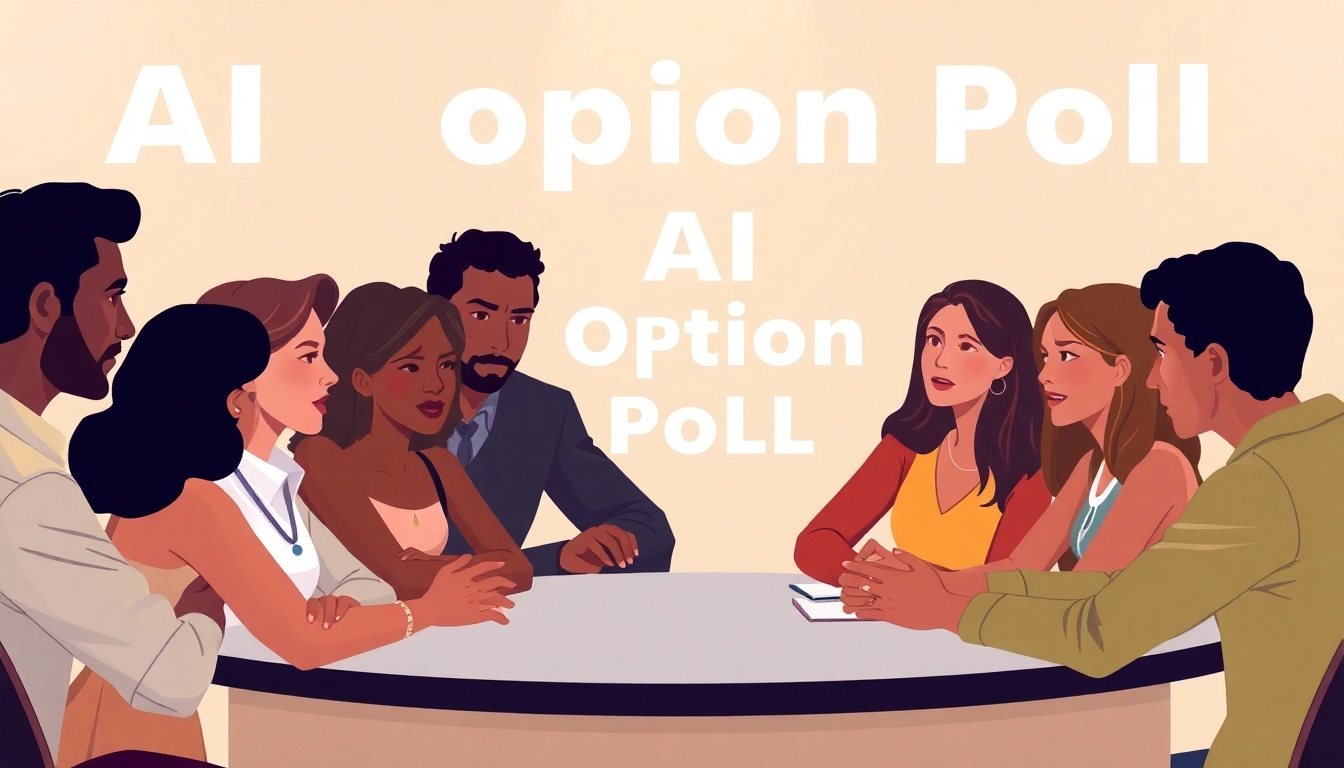1. Introduction to AI Opinion Polls
In recent years, artificial intelligence has emerged as one of the most transformative technologies, influencing diverse sectors such as healthcare, finance, and entertainment. However, the public’s perception of AI remains complex and multifaceted. Understanding public sentiment through AI Opinion polls is vital for shaping the future landscape of technology development and regulation.
1.1 What is an AI Opinion Poll?
An AI opinion poll is a survey designed to capture sentiments, concerns, and expectations surrounding artificial intelligence among various demographics. These polls can range from general inquiries about AI’s perceived benefits and risks to specific questions regarding ethical considerations and societal impacts. Conducted by various organizations, including educational institutions, think tanks, and tech companies, these polls provide crucial data to understand how different segments of society view AI.
1.2 Importance of Public Perception on AI
The importance of public perception regarding AI cannot be overstated. As AI technologies continue to permeate everyday life, understanding public attitudes helps stakeholders—ranging from policymakers to tech companies—make informed decisions. Positive sentiment can encourage investment and innovation, while widespread concerns may prompt calls for regulation and greater oversight. Notably, a recent Pew Research study highlighted that 52% of Americans reported being more concerned than excited about AI’s integration into daily life.
1.3 Overview of Current Trends in AI Sentiment
Trends in AI sentiment indicate a troubling dichotomy: while most people recognize the potential of AI to enhance productivity and daily life, significant concerns prevail about privacy, job displacement, and the ethical use of AI. Recent findings suggest that many view AI more as a threat than an opportunity, leading to growing skepticism. This sentiment is reflected in the increasing number of individuals advocating for transparent AI policies.
2. Key Findings from Recent AI Opinion Polls
2.1 General Attitudes Toward AI
General attitudes toward AI reveal a pronounced ambivalence. While developments in AI promise greater efficiency and innovation, surveys show that a significant number of people remain wary. For example, a recent Gallup survey indicated that a majority of adults believe AI presents more risks than benefits, especially regarding employment and misinformation transmission. Researchers found that perceptions vary widely based on demographics, including age, gender, and education level.
2.2 Concerns and Misconceptions about AI
Concerns about AI often stem from misconceptions and a lack of understanding of its capabilities and limitations. Issues such as job automation, ethical decision-making, and the potential for AI to generate biased outcomes continue to dominate public discourse. According to a study from YouGov, 40% of Americans believe that AI will have a negative impact on society, showing a rising awareness of the technology’s pitfalls in contrast to its promises.
2.3 Demographics of AI Sentiment Responses
Demographic variations significantly influence AI sentiment. Surveys reveal that women are generally more cautious about AI than men, often reflecting broader concerns about societal implications. Moreover, younger adults exhibit a more optimistic view of AI compared to older individuals, who may have lingering distrust rooted in historical technological disruptions. Educational background also plays a crucial role in shaping opinions—those with higher education levels tend to have a more nuanced understanding of AI’s potential, leading to more positive views.
3. Analyzing Factors Influencing Public Opinions on AI
3.1 Media Representation of AI
The portrayal of AI in media significantly shapes public perception. Coverage often oscillates between dystopian scenarios, depicting AI as a threat, and utopian visions that present it as a solution to pressing global challenges. As such, media outlets wield significant influence in framing the narrative around AI. Research indicates that sensationalized portrayals can amplify fear and skepticism while responsible reporting can foster awareness and understanding.
3.2 Impact of Personal Experience with AI
Personal experiences with AI technologies—whether through virtual assistants, recommendation algorithms, or automated customer service—also impact opinions. As users interact with AI systems, their experiences can influence overall sentiment, creating a paradox where widespread use does not necessarily equate to overall trust. For instance, a survey published by Axios found that while the majority of people use AI regularly, an alarming 72% expressed negative views about AI’s potential to spread false information, highlighting a critical gap between use and trust.
3.3 Role of Education in Shaping Perceptions
Educational initiatives play a crucial role in demystifying AI and addressing misconceptions. By equipping individuals with knowledge about AI’s functionality, benefits, and limitations, education fosters a more informed public discourse. Many institutions have begun implementing AI literacy programs aimed at raising awareness and understanding, aiming to bridge the knowledge gap and reduce fear associated with unknown technologies.
4. The Future of AI Based on Public Opinion
4.1 Predictions for AI Adoption Rates
As AI continues to advance, predictions for adoption rates suggest a gradual increase, provided that public concerns are adequately addressed. Analysts posit that as AI becomes more integrated into everyday technologies and services, acceptance will follow. However, for adoption rates to reach their potential, public trust must be built through transparency, accountability, and ethical practices in AI development.
4.2 Potential Policy Implications
Public opinion significantly influences policy decisions regarding AI. As concerns about civil liberties and accountability rise, we may see sharper regulations aimed at ensuring responsible AI deployment. Experts advocate for proactive policymaking that engages diverse stakeholders, promoting a cooperative approach to developing frameworks that can match the pace of technological advancements while keeping societal interests at the forefront.
4.3 Strategies for Bridging the Opinion Gap
To bridge the gap between public opinion and AI development, stakeholders can implement several strategies:
- Fostering Public Engagement: Initiatives that encourage dialogue between developers, policymakers, and community members can help demystify AI.
- Promoting Transparency: Open communication about AI capabilities, limitations, and risks can build trust.
- Implementing Education Programs: Regular workshops and resources can ensure individuals are informed about AI developments.
- Creating Ethical Guidelines: Establishing frameworks that prioritize ethical AI development can alleviate societal fears.
5. Conclusion: The Importance of Continuous Engagement
5.1 The Role of Continuous Polling
Continuous polling is pivotal for tracking shifts in public sentiment as AI evolves. Regularly gathering data allows for timely reflections on how sociocultural dynamics influence perceptions and provides insights that can drive further research and development.
5.2 Encouraging Public Dialogue on AI
Encouraging public dialogue about AI is essential for ensuring that community voices are heard. Community forums, public discussions, and educational campaigns can facilitate conversations about AI, allowing people to share their thoughts, concerns, and expectations, ultimately guiding the direction of AI innovations.
5.3 Final Thoughts on AI and Society
The integration of AI into society represents not only a technological evolution but also a cultural shift. As we navigate this new landscape, it is crucial to foster dialogue, transparency, and education around AI. By being proactive in addressing concerns and misconceptions, we can pave the way for a future where technology and societal needs align harmoniously.



